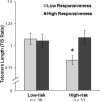Parental responsiveness moderates the association between early-life stress and reduced telomere length
- PMID: 23527512
- PMCID: PMC4312590
- DOI: 10.1017/S0954579413000011
Parental responsiveness moderates the association between early-life stress and reduced telomere length
Abstract
Early-life stress, such as maltreatment, institutionalization, and exposure to violence, is associated with accelerated telomere shortening. Telomere shortening may thus represent a biomarker of early adversity. Previous studies have suggested that responsive parenting may protect children from the negative biological and behavioral consequences of early adversity. This study examined the role of parental responsiveness in buffering children from telomere shortening following experiences of early-life stress. We found that high-risk children had significantly shorter telomeres than low-risk children, controlling for household income, birth weight, gender, and minority status. Further, parental responsiveness moderated the association between risk and telomere length, with more responsive parenting associated with longer telomeres only among high-risk children. These findings suggest that responsive parenting may have protective benefits on telomere shortening for young children exposed to early-life stress. Therefore, this study has important implications for early parenting interventions.
Figures




References
-
- Afifi TO, Macmillan HL. Resilience following child maltreatment: a review of protective factors. Canadian Journal of Psychiatry. 2011;56(5):266–272. - PubMed
-
- Benetos A, Okuda K, Lajemi M, Kimura M, Thomas F, Skurnick J, Aviv A. Telomere length as an indicator of biological aging: the gender effect and relation with pulse pressure and pulse wave velocity. Hypertension. 2001;37(2 Part 2):381–385. - PubMed
-
- Bernard K, Butzin-Dozier Z, Rittenhouse J, Dozier M. Cortisol production patterns in young children living with birth parents vs children placed in foster care following involvement of Child Protective Services. Archives of Pediatrics and Adolescent Medicine. 2010;164(5):438–443. doi: 10.1001/archpediatrics.2010.54. - PMC - PubMed
-
- Beyne-Rauzy O, Prade-Houdellier N, Demur C, Recher C, Ayel J, Laurent G, Mansat-De Mas V. Tumor necrosis factor-alpha inhibits hTERT gene expression in human myeloid normal and leukemic cells. Blood. 2005;106(9):3200–3205. doi: 10.1182/blood-2005-04-1386. - PubMed
Publication types
MeSH terms
Grants and funding
LinkOut - more resources
Full Text Sources
Other Literature Sources
Medical
